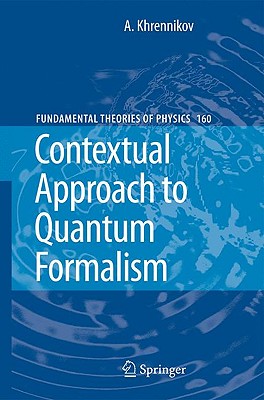
Contextual Approach to Quantum Formalism (Fundamental Theories of Physics #160)
Description
Part I: Quantum and Classical Probability Chapter 1: Quantum Mechanics: Postulates and Interpretations 1.1 Quantum Mechanics 1.1.1 Mathematical Basis 1.1.2 Postulates 1.2 Projection Postulate, Collapse of Wave Function, Schr\'odinger's Cat 1.2.1 Von Neumann's Projection Postulate 1.2.2 Collapse of Wave Function 1.2.3 Schr\'odinger's Cat 1.2.4 L\'uders Projection Postulate 1.3 Statistical Mixtures 1.4 Von Neumann's and L\'uders' Postulates for Mixed States 1.5 Conditional Probability 1.6 Derivation of Interference of Probabilities Chapter 2: Classical Probability Theories 2.1 Kolmogorov Measure-Theoretic Model 2.1.1 Formalism 2.1.2 Discussion 2.2 Von Mises Frequency Model 2.2.1 Collective (Random Sequence) 2.2.2 Difficulties with Definition of Randomness 2.2.3 $S$-sequences 2.2.4 Operations for Collectives 2.3 Combining and Independence of Collectives Part I I: Contextual Probability and\\ Quantum-Like Models Chapter 1: Contextual Probability and Interference 1.1 V\'axj\'o model: Contextual Probability 1.1.1 Contexts 1.1.2 Observables 1.1.3 Contextual Probability Space and Model 1.1.4 V\'axj\'o Models Induced by the Kolmogorov Model 1.1.5 V\'axj\'o Models Induced by QM 1.1.6 V\'axj\'o Models Induced by the von Mises Model 1.2 Contextual Probabilistic Description of Double Slit Experiment 1.3 Formula of Total Probability and Measures of Supplementarity 1.4 Supplementary Observables 1.5 Principle of Supplementarity 1.6 Supplementarity and Kolmogorovness 1.6.1 Double Stochasticity as the Law of Probabilistic Balance 1.6.2 Probabilistically Balanced Observables 1.6.3 Symmetrically Conditioned Observables 1.7 Incompatibility, Supplementarity and Existence of Joint Probability Distribution 1.7.1 Joint Probability Distribution 1.7.2 Incompatible and Supplementary Observables 1.7.3 Compatibility and Probabilistic Compatibility 1.8 Interpretational Questions 1.8.1 Contextuality 1.8.2 Realism 1.9 Historical Remark: Comparing with Mackey's Model 1.10 Subjective and Contextual Probabilities in Quantum Theory Chapter 2: Quantum-Like Representation of Contextual Probabilistic Model 2.1 Trigonometric, Hyperbolic, and Hyper-Trigonometric Contexts 2.2 Quantum-Like Representation Algorithm -- QLRA 2.2.1 Probabilistic Data about Context 2.2.2 Construction of Complex Probabilistic Amplitudes 2.3 Hilbert Space Representation of $b$-Observable 2.3.1 Born's Rule 2.3.2 Fundamental Physical Observable: Views of De Broglie and Bohm 2.3.3 $b$-Observable as Multiplication Operator 2.3.4 Interference 2.4 Hilbert Space Representation of $a$-Observable 2.4.1 Conventional Quantum and Quantum-Like Representations 2.4.2 $a$-Basis from Interference 2.4.3 Necessary and Sufficient Conditions for Born's Rule 2.4.4 Choice of Probabilistic Phases 2.4.5 Contextual Dependence of $a$-Basis 2.4.6 Existence of Quantum-Like Representation with Born's Rule for Both Reference Observables 2.4.7 Pathologies'' 2.5 Properties of Mapping of Trigonometric Contexts into Complex Amplitudes 2.5.1 Classical-Like Contexts 2.5.2 Non Injectivity of Representation Map 2.6 Non-Double Stochastic Matrix: Quantum-Like Representations 2.7 Noncommutativity of Operators Representing Observables 2.8 Symmetrically Conditioned Observables 2.8.1 $b$-Selections are Trigonometric Contexts 2.8.2 Extension of Representation Map 2.9 Formalization of the Notion of Quantum-Like Representation 2.10 Domain of Application of Quantum-Like Representation Algorithm Chapter 3: Ensemble Representation o.



